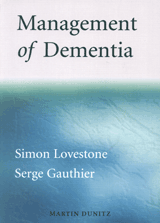by Simon Lovestone and Serge Gauthier, Martin Dunitz, 2001.
Reviewed by Chris MacKnight, MD, MSc, FRCPC, Assistant Professor, Dalhousie University.
 When I was asked to review this book I thought, Not another guide to dementia! I was right--this isn't yet another guide to dementia. It is an excellent, helpful and practical book, and one that I greatly enjoyed.
When I was asked to review this book I thought, Not another guide to dementia! I was right--this isn't yet another guide to dementia. It is an excellent, helpful and practical book, and one that I greatly enjoyed.
The authors, Drs. Serge Gauthier and Simon Lovestone, are experienced and respected experts in dementia, and they have distilled that experience into 150 easily read and understood pages. Being from both sides of the Atlantic, they bring a nice trans-continental perspective to the book, and their respect for their patients is evident on every page.
The authors don't get bogged down in the minutiae of pathophysiology and pharmacology, but rather present what a practitioner needs to know to get the job done. They begin with a chapter on the newly diagnosed patient, and follow with chapters on common behavioural problems (including one on sleep), treatment of the cognitive symptoms, the possibility of disease modification and, finally, a chapter on long-term care, including the design of the facility.
There are a number of excellent features in this book. The end section contains many instruments commonly used in assessing and following patients with dementia, complete with guides for their use. I particularly enjoyed the cases, scattered throughout the text, that aptly illustrated the management issues and were very real-life. The references at the end of each chapter are both comprehensive and current.
I highly recommend this book to trainees and clinicians (both physicians and non-physicians) who see patients with dementia. Most nursing homes, if not every nursing home ward, should have a copy on hand. Even a specialist is likely to learn something from these pages. Unlike so many books I see, I believe I'll actually use this one.